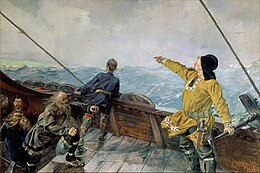
Back Сага за гренландците Bulgarian Saga dels Groenlandesos Catalan Grønlændernes saga Danish Grænlendinga saga German Saga Grœnlendinga Spanish Gröönlaste saaga Estonian Groenlandiarren saga Basque Grœnlendinga-saaga Finnish Grœnlendinga saga French Grænlendinga saga Icelandic
| Part of a series on the |
| Norse colonization of North America |
|---|
 |
Grœnlendinga saga () (spelled Grænlendinga saga in modern Icelandic and translated into English as the Saga of the Greenlanders) is one of the sagas of Icelanders. Like the Saga of Erik the Red, it is one of the two main sources on the Norse colonization of North America. The saga recounts events that purportedly happened around 1000[1] and is preserved only in the late 14th century Flateyjarbók manuscript.
The Saga of the Greenlanders starts with Erik the Red, who leaves Norway and colonizes Greenland. It then relates six expeditions to North America, led respectively by Bjarni Herjolfsson, Leif Erikson, Thorvald Eriksson, Thorstein Eriksson and his wife Gudrid Thorbjarnardóttir, Thorfinn Karlsefni, and Freydís Eiríksdóttir. Bjarni and his crew discover three lands by chance during their voyage to Greenland, but they never set foot on the lands themselves. Leif learns about Bjarni's encounters and, after buying Bjarni's ship, sails to the lands to explore them. During his adventures, Leif names the three lands Helluland, Markland, and Vinland. Later, Thorvald, Leif's brother, sets sail to Vinland and lives there until he gets killed by the natives in a combat. Thorstein and Gudrid attempt to travel to Vinland but eventually fail, and thereafter Thorstein dies of an illness. Karlsefni, who then marries Gudrid, journeys to Vinland and stays there until the following spring. The final expedition is made by Freydís, who sails to Vinland with the brothers Helgi and Finnbogi but eventually slaughters their crew and returns to Greenland.
The date of the saga's composition has been debated among scholars for decades. Some have argued that the saga was written around the beginning of the 13th century, while others have dated it to the late 13th century or even the 14th century. Attempts have also been made to determine the credibility of the different expedition stories in the saga, and they often involve close comparisons between the Saga of the Greenlanders and the Saga of Erik the Red. The current consensus is that although certain parts of the saga are fanciful, much appears to be based on historical truth.